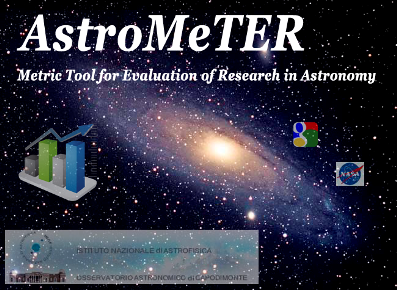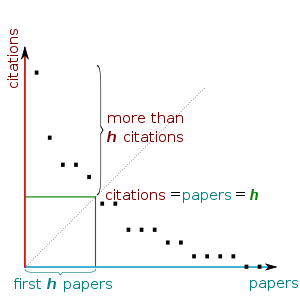
 |
|---|
Welcome to the AstroMeTER @ INAF - OACN
Metric Tool for Evaluation of Research in Astronomy
Main scope of AstroMeTER is to provide to the astronomical community a simple and fast resource to perform metric calculations on science productivity of its members.
The utility is able to perform:
The current beta release of the program AstroMeTER performs three kinds of bibliometrics calculations, named H, Contemporary H and G indices, respectively, both based on the citations retrieved for author's publication lists. The program exploits two of the most common publication search engines, for instance ADS and Google Scholar.
The H index, also known as Hirsch index, was created by Jorge E. Hirsch, a physicist at UCSD, and presented in his paper "An index to quantify an individual's scientific research output" in November 2005.
The index is based on the distribution of citations associated to a given author's publication list.
The concept behind H index is quite simple: an author has index H if his H papers, on a total amount of N ranked in decreasing order of citation number, have at least H citations each, and the other (N − H) papers have no more than H citations each, as shown below.

More simply, an author with an index of H has published H papers, each one cited somewhere (basically in other papers) at least H times.
Thus, the H index reflects both the number of publications and the number of citations per publication. The index is designed to improve upon simpler measures such as the total number of citations or publications. The index works properly only for comparing scientists working in the same field; citation conventions differ widely among different fields and search engines.
For ranking scientists and journals, besides the Hirsch index proposed as pioneering metric, recently a modified version, known as Contemporary h index has been proposed. In an article of 2007 (Sidiropoulos, Katsaros and Manolopoulos 2007) the authors demonstrate several inefficiencies of the original H index and develop a pair of generalizations and effective variants of it to deal with scientist ranking and publication forum ranking. The new citation indices are able to disclose trendsetters in scientific research, as well as researchers that constantly shape their field with their influential work, no matter how old they are.
The index is based on the normalization of citations based on the elapsed number of years since the paper publication. The original h-index does not take into account the age of an article. It may be the case that some scientist contributed a number of significant articles that produced a large h-index, but now he is rather inactive or retired. Therefore, senior scientists, who keep contributing nowadays, or brilliant young scientists, who are expected to contribute a large number of significant works in the near future but now they have only a small number of important articles due to the time constraint, are not distinguished by the original h-index. Thus, it arises the need of defining a generalization of the h-index, in order to account for these facts. The H contemporary index starts from a novel score Sc(i) for an article i based on citation counting, as follows:
Sc(i) = g * |C(i)| * [(Current_Year - Published_Year(i) + 1)^-d]
where g is an empirical constant fixed to value 4; C(i) is the number of citations of paper i; Published_Year(i) is the year of publication of paper i and d is the exponent fixed to value 1.
Then the contemporary h index is calculated as the traditional h index applied on the resulted normalized citation list (by opportunely re-ordering of publications in decremental citation order). See the publication cited above for more details.
The G index, also known as Egghe index, was created by Leo Egghe, who presented it in his paper "Theory and practise of the g-index" in the 2006.
Like H index, the concept behind G index is simple: given a set of publications ranked in decreasing order of the number of citations, the G index is the (unique) largest number such that the top G articles received (together) at least g2 citations.
It is indeed evident that the G index is useful for quantifying scientific productivity based on publication record.
The G index has a quite obvious property: it states that by moving citations from weaker articles to stronger articles, one's research index should not decrease.
By directly comparing H and G values, it results clear that both factors are strongly correlated. However, these factors are conceptually distinct, in the sense that the G index attempts to address shortcomings of the H index.
Journal Impact Factor is from Journal Citation Report (JCR), a product of Thomson ISI (Institute for Scientific Information).
JCR provides quantitative tools for evaluating journals and the impact factor is one of these. It is a measure of the frequency with which the "average article" in a journal has been cited in a given period of time.
The impact factor for a journal is calculated based on a three-year period, and can be considered to be the average number of times published papers are cited up to two years after publication. For example, the impact factor 2011 for a journal would be calculated as follows:
(note that the impact factor 2010 will be actually published in 2011, because it could not be calculated until all of the 2010 publications had been received. Impact factor 2011 will be published in 2012)
Impact factor of Nature, Science and Cell journals can be found on their journal websites.
The lists of Impact Factors cannot be published on this site due to copyright violations. Science Watch provides ranking and impact factor for selective journals. The complete list is located at this address.
The impact factor can be used to perform a fine tuned evaluation for an author, after a publication search with option "grouping by journal name" enabled in the calculation form. It infacts reports also normalized citation number (i.e. citations/num_authors).
As introduced above, the current beta release of the program exploits two bibliography search engines: ADS and Google Scholar.
It is also to be remarked that the main reference for all calculations is the ADS outcome. Google Scholar is less reliable in terms of publications, but it is more powerful to find an higher number of citations. This is because it is able to search for citations in a wider range of internet sources than ADS.
The choice has been basically driven by their common practice and frequency of use in astronomy bibliography search. Other resources, like Spires, or Mendeley have been also put in the program release progress pipeline.
One of main scopes of the AstroMeTER program is to provide to the astronomical community a simple and fast resource to perform metric calculations on science productivity of its members.
Together with the enhancement of this resource through the integration of mentioned database engines, it is also foreseen to provide other metrics, based, for instance, on more fine search options, by using the specific impact factors of single journals. As known, in fact, the H and G indices are only indirectly related with the different journal ranks, which however may have a more relevant impact in the research productivity evaluation of a scientist.
The program is under frequent update and it is open to the community. Suggestions, bug reports, new ideas are always welcome and encouraged!